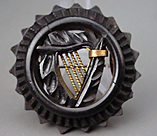
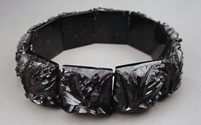
There are three main ways in which plants, or parts of them, can become fossilized so as to later be desirable as gemstones or ornamental gem materials: 1) they become compressed, compacted and altered over time, 2) they are replaced by mineral solutions 3) by slowly decaying in soft sediments they leave impressions or casts.
In some cases the original organic structures come to be buried by sediments, often in an oxygen-poor environment, where over time, high temperatures and pressures compact and compress them, while chemical changes are occurring which favor the formation of polymer-like or hydrocarbon molecules. The most familiar gem materials of this type are bog oak and jet, when the original material was wood, and copal and amber, when the original material was resin.
Such gems are considered to be of organic origin as the molecules of which they are composed (although highly altered) are still largely those from the original living source. In general, the longer the period of burial, compression and chemical change, the more the characteristics of the material are altered.
Bog oak comes from hardwood trees which were long ago buried in acidic peat bogs. The primary source for the material in use today is Ireland. Although considerable change in the character of the original wood molecules has occurred, bog oak, under magnification, still shows some graining and other signs which reveal its woody nature. Jet, which comes from far older buried wood deposits, has undergone substantially more change, and retains no such outer signs. Physically, jet is more stable and compact and takes a better polish than bog oak. The main sources for the jet in today's gem market are England and China.


Copal and amber have a similar relationship in that they both originated as resin secreted from trees, but copal being much younger is less compact, hard, and stable than is the far older amber. The really interesting situation with amber and copal as plant fossils, is that they can have other plant fossils inside them! Pollen grains, bits of bark and leaf debris are very common, and mostly go unnoticed and unidentified in fossil resins, but the occasional intact leaf or flower makes a notable find.

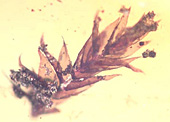
Although the source of "petrified" plants was, indeed, the original living object, those molecules have long since decayed away, and have subsequently been replaced by minerals from the surrounding environment. As a result, such gems are not classed as organic, but rather as mineral gems.
Petrifaction, then, is the process in which, particle by particle, structures of a dead organism are replaced by mineral solutions, usually silicon dioxide. As a result, a perfect replica of the organic material is produced in agate, chalcedony or opal. If the original object was a woody plant the resulting stone is called petrified or fossilized wood. Technically this should be referred to as "a chalcedony pseudomorph after wood" but outside of academic circles, "petrified" will do just fine. Petrifaction is almost exclusively limited to the "hard" parts of plants such as wood, cones and seeds.

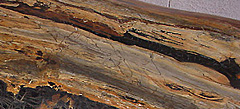
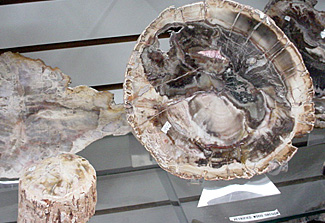
Huge deposits of brightly colored pieces have been found in Northern Arizona with black, red or yellow silica colored by iron or other trace minerals. Depending on the orientation of the slice and the conditions of petrifaction, there may or may not be clear annular rings or other woody structures visible. Most of this material is used for specimens or ornamental objects such as bookends, and in comparison, relatively few pieces are used for jewelry.

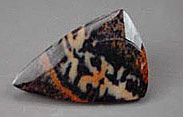
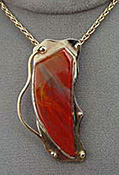

Rarer types of wood such as palmwood and tree fern wood are also seen and are favorites with collectors and jewelry designers as well. The interesting patterns that appear in such pieces may reflect the internal anatomy of the tree, such as that of the layout of the vascular bundles through which water is conducted from the roots to the leaves. Depending on the orientation of the slice such features could appear as rings, parallel lines, dots or streaks. The special case of "peanut wood" is interesting in that it is the petrified remains of wood buried in marine sediments which before petrifaction had been infested with a burrowing mollusk. The silt filled burrows of those wood parasites also fossilized leaving the "peanut" shaped markings.
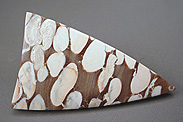

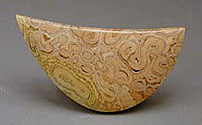
Also included in this group of petrified hard parts would be roots, bark, burls, cones and other such tree or plant structures. When the organic/mineral replacement is complete, these pieces are as hard as any agate or chalcedony, and are suitable for jewelry use with no special care necessary.
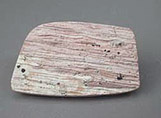
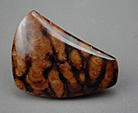

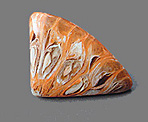
Yet another way that plant parts can become immortalized in stone is by leaving an impression. When very fine, soft sediments quickly cover fleshy organic parts of plants such as leaves, these can decay very slowly in the, now, oxygen-poor environment. This slow decay allows them to leave stains upon, or even actual casts of themselves, in the forming rock, as the silt and mud slowly compact and harden around them. Later, such rocks, which tend to split easily along layers, may be opened to reveal beautiful evidence of the once buried plant structure. These specimens are more delicate than petrified gems, but with care, many can be used in jewelry.
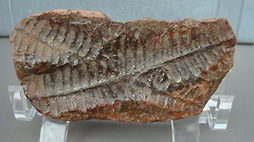
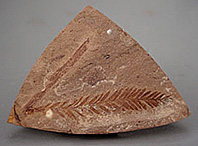
Some natural mineral inclusions look very plant-like and can, at first glance, be mistaken for fossils. Examples would be the tree and moss like inclusions of iron oxide and manganese oxide that invade cracks within crystals, or between rock layers to form branching crystalline structures known as "dendrites".
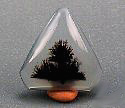
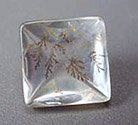
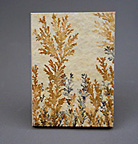
It is hard to generalize about such a highly diverse group, but one cannot go wrong to say that the rarer, more perfect, and beautiful the fossil, and its state of preservation the better. For petrified gems the highest value is attached to those pieces which are fully agatized with no soft spots or gaps and which are well proportioned, beautifully cut, and with an excellent polish. Fossil hard and soft woods are more common than palm or tree fern, and therefore less expensive.